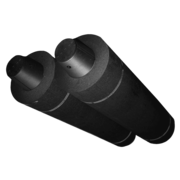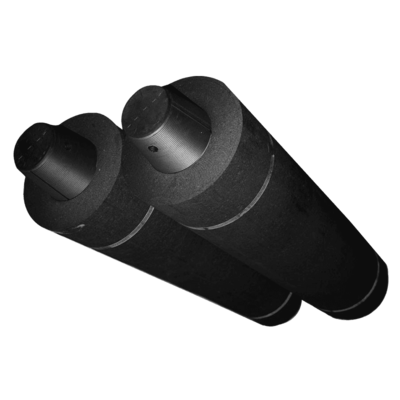https://www.graptek.com/products/graphite-electrode.html
Graphite electrode, a conductor that releases electric energy in the form of an electric arc, is used to heat and melt the steel scraps in an electric arc furnace. They are currently the only products with high electrical conductivity and are able to maintain extremely high heat generation in this demanding environment. With the growing demand for quality steel in the aerospace, automotive and electronics industries, graphite electrodes are also becoming increasingly popular.
WHY GRAPHITE ELECTRODE?
A pile of graphite powder on the white background.
Graphite material has better electrochemical stability. This type of electrode has low loss ratio.
Graphite electrode is easy to process and the processing speed is obviously faster than that of copper electrode.
Graphite is light in weight and has good thermal & electrical conductivity.
Graphite electrode, with above irreplaceable performance advantages, plays an indispensable role in the high temperature manufacturing field such as iron and steel smelting, electrolytic aluminum, ferroalloy, calcium carbide, industrial silicon and yellow phosphorus smelting.
CLASSIFICATION OF GRAPHITE ELECTRODES
According to the electric furnace capacity, transformer power load, the difference of raw materials used in the electrodes production and the physical & chemical indexes of finished electrodes, the graphite electrodes are divided into three types:
A UHP graphite electrode with large diameter.
UHP GRAPHITE ELECTRODE.
It is made of high-grade needle coke and treated with Lengthwise Graphitization (LWG). The graphitization temperature can be up to 2800 °C – 3000 °C. Finished products have lower electrical resistance & linear expansion, good thermal shock resistance and allow a larger current density.
There is a black HP graphite electrodes with nipple.
HP GRAPHITE ELECTRODE.
It adopts quality petroleum coke or low grade needle coke as raw material. Its physical and mechanical properties are higher than RP graphite electrode such as lower electrical resistance and allowing a greater current density.
There are two regular power graphite electrodes.
RP GRAPHITE ELECTRODE.
Ordinary grade petroleum coke is adopted for production. This type of graphite electrode is treated with low graphitization temperature. The allowable current density is lower than HP graphite electrode's. Regular power graphite electrodes are specified with allowable current density less than 17 A/cm2.
MAIN APPLICATIONS
Electric arc furnace for non ferrous metal production.
EAF STEELMAKING.
EAF steelmaking is the main application field of graphite electrode. The output of electric arc furnace steel in China accounts for about 18% of crude steel. 70% – 80% of consumption of the graphite electrode are used in EAF steelmaking. In EAF steelmaking, the graphite electrode is used to conduct electric current into the furnace. And the high temperature heat source for smelting is generated by arcing between the electrode and steel scraps.
Submerged arc furnace for rebar mill.
SUBMERGED ARC FURNACE
Submerged arc furnace is mainly used in the production of industrial yellow phosphorus and silicon. It is required to use a graphite electrode for a submerged electric furnace with a high current density. It takes about 100 kg of graphite electrode to produce 1 t of silicon, and about 40 kg of graphite electrode to produce 1 t of yellow phosphorus.
Ladle metallurgy furnace in steelmaking plant.
LF (LADLE FURNACE)
The ladle furnace is set up in the EAF steelmaking plant. After the slag is mixed out, ladle furnace is used to complete the task of further reduction and refining. Commonly, graphite electrodes are used for three-phase AC ladle furnaces.
MAIN FACTORS AFFECTING GRAPHITE ELECTRODE CONSUMPTION IN EAF STEELMAKING
There are three half-used graphite electrodes.
The top reasons of loss and consumption of graphite electrodes are overload and timeout operation.
Low quality or improper proportion of scrap leads to poor slagging effect and prolong smelting time.
The increased feeding times lead to higher probability of electrode bottom damage and fracture.
Electric furnace power supply equipment does not match the electrode specifications.
The selection of power curve & gear, the voltage & current control of starting and stabilizing arcs, the use of long, medium and short arcs and the configuration of water cooling system are important to the service life and consumption of electrodes.
The quality of the graphite electrode itself affects the consumption ratio. Nowadays, the smelting and process of electric arc furnaces have higher requirements on the anti-oxidation performance and thermal shock resistance of graphite electrodes. Moreover, the high consumpti

